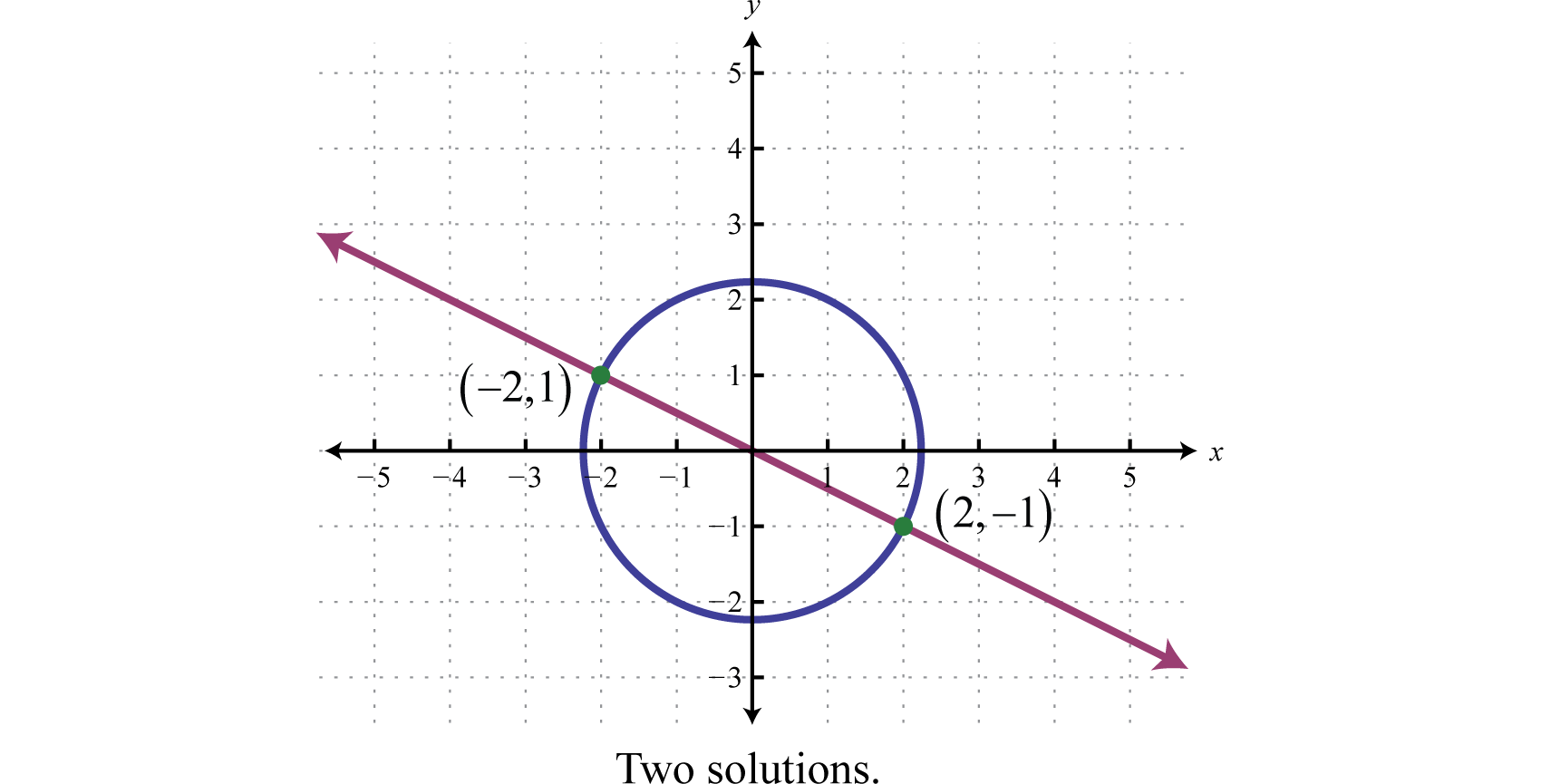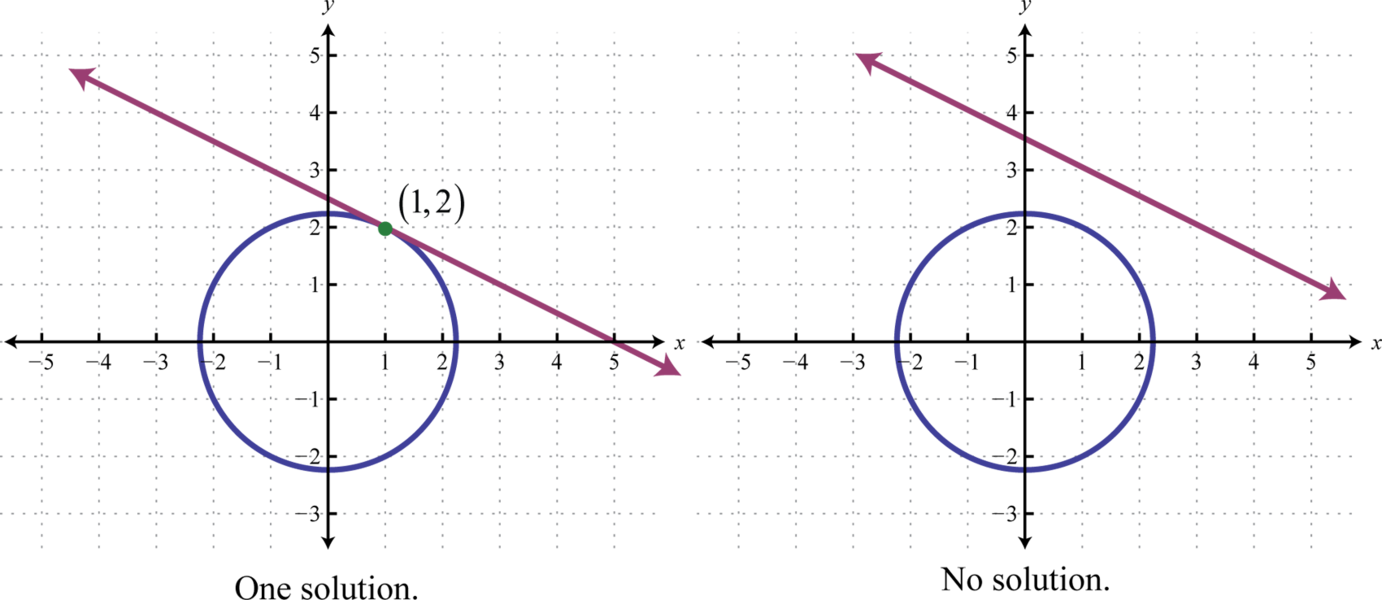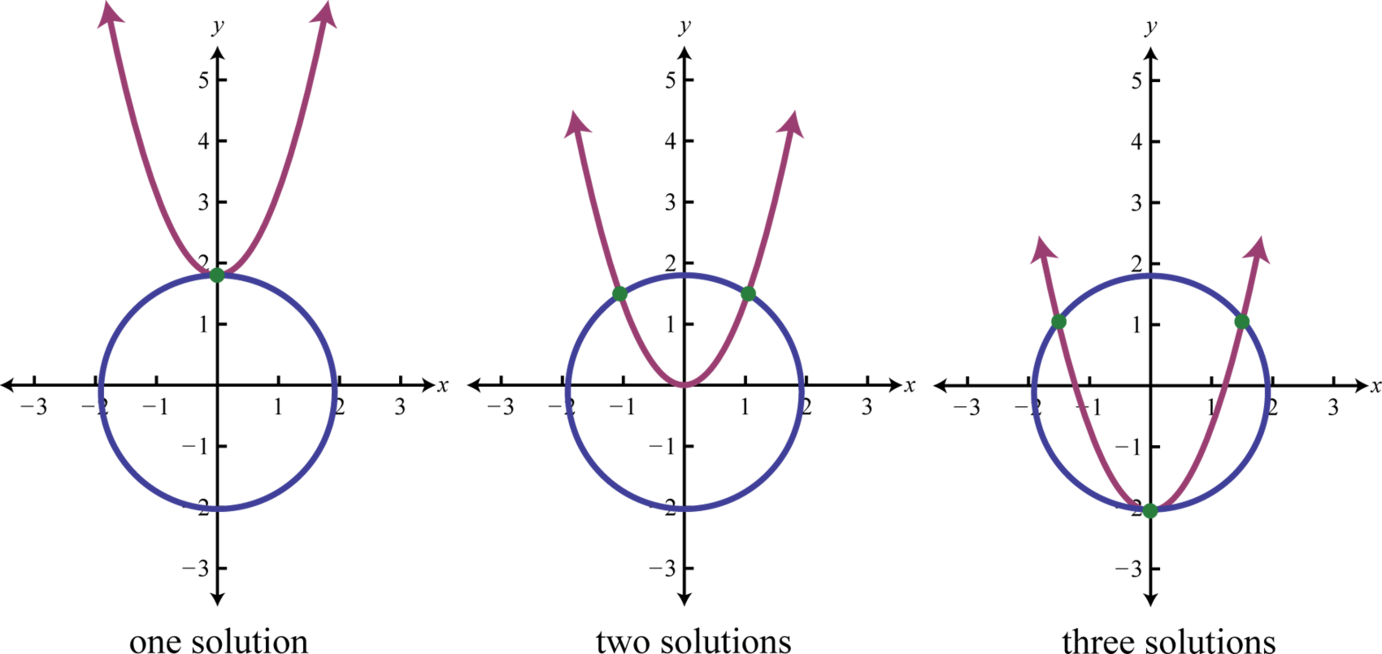8.5: Solving Nonlinear Systems
- Page ID
- 6286
\( \newcommand{\vecs}[1]{\overset { \scriptstyle \rightharpoonup} {\mathbf{#1}} } \)
\( \newcommand{\vecd}[1]{\overset{-\!-\!\rightharpoonup}{\vphantom{a}\smash {#1}}} \)
\( \newcommand{\dsum}{\displaystyle\sum\limits} \)
\( \newcommand{\dint}{\displaystyle\int\limits} \)
\( \newcommand{\dlim}{\displaystyle\lim\limits} \)
\( \newcommand{\id}{\mathrm{id}}\) \( \newcommand{\Span}{\mathrm{span}}\)
( \newcommand{\kernel}{\mathrm{null}\,}\) \( \newcommand{\range}{\mathrm{range}\,}\)
\( \newcommand{\RealPart}{\mathrm{Re}}\) \( \newcommand{\ImaginaryPart}{\mathrm{Im}}\)
\( \newcommand{\Argument}{\mathrm{Arg}}\) \( \newcommand{\norm}[1]{\| #1 \|}\)
\( \newcommand{\inner}[2]{\langle #1, #2 \rangle}\)
\( \newcommand{\Span}{\mathrm{span}}\)
\( \newcommand{\id}{\mathrm{id}}\)
\( \newcommand{\Span}{\mathrm{span}}\)
\( \newcommand{\kernel}{\mathrm{null}\,}\)
\( \newcommand{\range}{\mathrm{range}\,}\)
\( \newcommand{\RealPart}{\mathrm{Re}}\)
\( \newcommand{\ImaginaryPart}{\mathrm{Im}}\)
\( \newcommand{\Argument}{\mathrm{Arg}}\)
\( \newcommand{\norm}[1]{\| #1 \|}\)
\( \newcommand{\inner}[2]{\langle #1, #2 \rangle}\)
\( \newcommand{\Span}{\mathrm{span}}\) \( \newcommand{\AA}{\unicode[.8,0]{x212B}}\)
\( \newcommand{\vectorA}[1]{\vec{#1}} % arrow\)
\( \newcommand{\vectorAt}[1]{\vec{\text{#1}}} % arrow\)
\( \newcommand{\vectorB}[1]{\overset { \scriptstyle \rightharpoonup} {\mathbf{#1}} } \)
\( \newcommand{\vectorC}[1]{\textbf{#1}} \)
\( \newcommand{\vectorD}[1]{\overrightarrow{#1}} \)
\( \newcommand{\vectorDt}[1]{\overrightarrow{\text{#1}}} \)
\( \newcommand{\vectE}[1]{\overset{-\!-\!\rightharpoonup}{\vphantom{a}\smash{\mathbf {#1}}}} \)
\( \newcommand{\vecs}[1]{\overset { \scriptstyle \rightharpoonup} {\mathbf{#1}} } \)
\( \newcommand{\vecd}[1]{\overset{-\!-\!\rightharpoonup}{\vphantom{a}\smash {#1}}} \)
\(\newcommand{\avec}{\mathbf a}\) \(\newcommand{\bvec}{\mathbf b}\) \(\newcommand{\cvec}{\mathbf c}\) \(\newcommand{\dvec}{\mathbf d}\) \(\newcommand{\dtil}{\widetilde{\mathbf d}}\) \(\newcommand{\evec}{\mathbf e}\) \(\newcommand{\fvec}{\mathbf f}\) \(\newcommand{\nvec}{\mathbf n}\) \(\newcommand{\pvec}{\mathbf p}\) \(\newcommand{\qvec}{\mathbf q}\) \(\newcommand{\svec}{\mathbf s}\) \(\newcommand{\tvec}{\mathbf t}\) \(\newcommand{\uvec}{\mathbf u}\) \(\newcommand{\vvec}{\mathbf v}\) \(\newcommand{\wvec}{\mathbf w}\) \(\newcommand{\xvec}{\mathbf x}\) \(\newcommand{\yvec}{\mathbf y}\) \(\newcommand{\zvec}{\mathbf z}\) \(\newcommand{\rvec}{\mathbf r}\) \(\newcommand{\mvec}{\mathbf m}\) \(\newcommand{\zerovec}{\mathbf 0}\) \(\newcommand{\onevec}{\mathbf 1}\) \(\newcommand{\real}{\mathbb R}\) \(\newcommand{\twovec}[2]{\left[\begin{array}{r}#1 \\ #2 \end{array}\right]}\) \(\newcommand{\ctwovec}[2]{\left[\begin{array}{c}#1 \\ #2 \end{array}\right]}\) \(\newcommand{\threevec}[3]{\left[\begin{array}{r}#1 \\ #2 \\ #3 \end{array}\right]}\) \(\newcommand{\cthreevec}[3]{\left[\begin{array}{c}#1 \\ #2 \\ #3 \end{array}\right]}\) \(\newcommand{\fourvec}[4]{\left[\begin{array}{r}#1 \\ #2 \\ #3 \\ #4 \end{array}\right]}\) \(\newcommand{\cfourvec}[4]{\left[\begin{array}{c}#1 \\ #2 \\ #3 \\ #4 \end{array}\right]}\) \(\newcommand{\fivevec}[5]{\left[\begin{array}{r}#1 \\ #2 \\ #3 \\ #4 \\ #5 \\ \end{array}\right]}\) \(\newcommand{\cfivevec}[5]{\left[\begin{array}{c}#1 \\ #2 \\ #3 \\ #4 \\ #5 \\ \end{array}\right]}\) \(\newcommand{\mattwo}[4]{\left[\begin{array}{rr}#1 \amp #2 \\ #3 \amp #4 \\ \end{array}\right]}\) \(\newcommand{\laspan}[1]{\text{Span}\{#1\}}\) \(\newcommand{\bcal}{\cal B}\) \(\newcommand{\ccal}{\cal C}\) \(\newcommand{\scal}{\cal S}\) \(\newcommand{\wcal}{\cal W}\) \(\newcommand{\ecal}{\cal E}\) \(\newcommand{\coords}[2]{\left\{#1\right\}_{#2}}\) \(\newcommand{\gray}[1]{\color{gray}{#1}}\) \(\newcommand{\lgray}[1]{\color{lightgray}{#1}}\) \(\newcommand{\rank}{\operatorname{rank}}\) \(\newcommand{\row}{\text{Row}}\) \(\newcommand{\col}{\text{Col}}\) \(\renewcommand{\row}{\text{Row}}\) \(\newcommand{\nul}{\text{Nul}}\) \(\newcommand{\var}{\text{Var}}\) \(\newcommand{\corr}{\text{corr}}\) \(\newcommand{\len}[1]{\left|#1\right|}\) \(\newcommand{\bbar}{\overline{\bvec}}\) \(\newcommand{\bhat}{\widehat{\bvec}}\) \(\newcommand{\bperp}{\bvec^\perp}\) \(\newcommand{\xhat}{\widehat{\xvec}}\) \(\newcommand{\vhat}{\widehat{\vvec}}\) \(\newcommand{\uhat}{\widehat{\uvec}}\) \(\newcommand{\what}{\widehat{\wvec}}\) \(\newcommand{\Sighat}{\widehat{\Sigma}}\) \(\newcommand{\lt}{<}\) \(\newcommand{\gt}{>}\) \(\newcommand{\amp}{&}\) \(\definecolor{fillinmathshade}{gray}{0.9}\)Learning Objectives
- Identify nonlinear systems.
- Solve nonlinear systems using the substitution method.
Nonlinear Systems
A system of equations where at least one equation is not linear is called a nonlinear system32. In this section we will use the substitution method to solve nonlinear systems. Recall that solutions to a system with two variables are ordered pairs \((x,y)\) that satisfy both equations.
Example \(\PageIndex{1}\):
Solve: \(\left\{\begin{array}{l}{x+2 y=0} \\ {x^{2}+y^{2}=5}\end{array}\right.\).
Solution
In this case we begin by solving for x in the first equation.
\(\left\{\begin{array}{c}{x+2 y=0} \\ {x^{2}+y^{2}=5}\end{array}\Longrightarrow x=-2y \right.\)
Substitute \(x=−2y\) into the second equation and then solve for \(y\).
\(\begin{aligned}(\color{Cerulean}{-2y }\color{black}{)}^{2}+y^{2} &=5 \\ 4 y^{2}+y^{2} &=5 \\ 5 y^{2} &=5 \\ y^{2} &=1 \\ y &=\pm 1 \end{aligned}\)
Here there are two answers for \(y\); use \(x=−2y\) to find the corresponding \(x\)-values.
| Using \(y=-1\) | Using \(y=1\) |
|---|---|
| \(\begin{aligned} x &=-2 y \\ &=-2(-1) \\ &=2 \end{aligned}\) | \(\begin{aligned} x &=-2 y \\ &=-2(1) \\ &=-2 \end{aligned}\) |
This gives us two ordered pair solutions, \((2,−1)\) and \((−2,1)\).
Answer:
\((2,−1), (−2,1)\)
In the previous example, the given system consisted of a line and a circle. Graphing these equations on the same set of axes, we can see that the two ordered pair solutions correspond to the two points of intersection.

If we are given a system consisting of a circle and a line, then there are \(3\) possibilities for real solutions—two solutions as pictured above, one solution, or no solution.

Example \(\PageIndex{2}\)
Solve: \(\left\{\begin{array}{c}{x+y=3} \\ {x^{2}+y^{2}=2}\end{array}\right.\).
Solution
Solve for \(y\) in the first equation.
\(\left\{\begin{array}{c}{x+y} \\ {x^{2}+y^{2}}\end{array}\right.\)
Next, substitute \(y=3−x\) into the second equation and then solve for \(x\).
\(\begin{array}{r}{x^{2}+(\color{Cerulean}{3-x}\color{black}{)}^{2}=2} \\ {x^{2}+9-6 x+x^{2}=2} \\ {2 x^{2}-6 x+9=2} \\ {2 x^{2}-6 x+7=0}\end{array}\)
The resulting equation does not factor. Furthermore, using \(a=2\),\( b=−6\), and \(c=7\) we can see that the discriminant is negative:
\(\begin{aligned} b^{2}-4 a c &=(-6)^{2}-4(2)(7) \\ &=36-56 \\ &=-20 \end{aligned}\)
We conclude that there are no real solutions to this equation and thus no solution to the system.
Answer:
\(Ø\)
Exercise \(\PageIndex{1}\)
Solve: \(\left\{\begin{aligned} x-y &=5 \\ x^{2}+(y+1)^{2} &=8 \end{aligned}\right.\)
- Answer
-
\((2,−3)\)
www.youtube.com/v/ToIrjw-8SNA
If given a circle and a parabola, then there are \(5\) possibilities for solutions.


When using the substitution method, we can perform the substitution step using entire algebraic expressions. The goal is to produce a single equation in one variable that can be solved using the techniques learned up to this point in our study of algebra.
Example \(\PageIndex{3}\):
Solve: \(\left\{\begin{array}{c}{x^{2}+y^{2}=2} \\ {y-x^{2}=-2}\end{array}\right.\).
Solution
We can solve for \(x^{2}\) in the second equation.
\(\left\{\begin{array}{l}{x^{2}+y^{2}=2} \\ {y-x^{2}=-2 \quad \Rightarrow \quad y+2=x^{2}}\end{array}\right.\)
Substitute \(x^{2}=y+2\) into the first equation and then solve for \(y\).
\(\begin{aligned} \color{Cerulean}{y+2}\color{black}{+}y^{2} &=2 \\ y^{2}+y &=0 \\ y(y+1) &=0 \\ y &=0 \quad \text { or } \quad y=-1 \end{aligned}\)
Back substitute into \(x^{2}=y+2\) to find the corresponding \(x\)-values.
| Using \(y=-1\) | Using \(y=0\) |
|---|---|
| \(\begin{aligned} x^{2} &=y+2 \\ x^{2} &=\color{Cerulean}{-1}\color{black}{+}2 \\ x^{2} &=1 \\ x &=\pm 1 \end{aligned}\) | \(\begin{aligned} x^{2} &=y+2 \\ x^{2} &=\color{Cerulean}{0}\color{black}{+}2 \\ x^{2} &=2 \\ x &=\pm \sqrt{2} \end{aligned}\) |
This leads us to four solutions, \((±1,−1)\) and \((\pm \sqrt{2}, 0)\).
Answer:
\((\pm 1,-1),(\pm \sqrt{2}, 0)\)
Example \(\PageIndex{4}\)
Solve: \(\left\{\begin{aligned}(x-1)^{2}-2 y^{2} &=4 \\ x^{2}+y^{2} &=9 \end{aligned}\right.\)
Solution
We can solve for \(y^{2}\) in the second equation,
\(\left\{\begin{array}{r}{(x-1)^{2}-2 y^{2}=4} \\ {x^{2}+y^{2}=9}\end{array}\right. \Longrightarrow y^{2}=9-x^{2}\)
Substitute \(y^{2}=9−x^{2}\) into the first equation and then solve for \(x\).
\(\begin{aligned}(x-1)^{2}-2\color{black}{\left(\color{Cerulean}{9-x^{2}}\right) }&=4 \\ x^{2}-2 x+1-18+2 x^{2} &=0 \\ 3 x^{2}-2 x-21 &=0 \\(3 x+7)(x-3) &=0 \\ 3 x+7 &=0 \text { or } x-3=0 \\ x &=-\frac{7}{3} \quad x=3 \end{aligned}\)
Back substitute into \(y^{2}=9−x^{2}\) to find the corresponding \(y\)-values.
| Using \(x=-\frac{7}{3}\) | Using \(x=3\) |
|---|---|
| \(\begin{array}{l}{y^{2}=9-\color{black}{\left(\color{Cerulean}{-\frac{7}{3}}\right)^{2}}} \\ {y^{2}=\frac{9}{1}-\frac{49}{9}} \\ {y^{2}=\frac{32}{9}} \\ {y=\pm \frac{\sqrt{32}}{3}=\pm \frac{4 \sqrt{2}}{3}}\end{array}\) | \(\begin{aligned} y^{2} &=9-(\color{Cerulean}{3}\color{black}{)}^{2} \\ y^{2} &=0 \\ y &=0 \end{aligned}\) |
This leads to three solutions, \(\left(-\frac{7}{3}, \pm \frac{4 \sqrt{2}}{3}\right)\) and \((3,0)\).
Answer:
\((3,0),\left(-\frac{7}{3}, \pm \frac{4 \sqrt{2}}{3}\right)\)
Example \(\PageIndex{5}\)
Solve: \(\left\{\begin{aligned} x^{2}+y^{2} &=2 \\ x y &=1 \end{aligned}\right.\).
Solution
Solve for \(y\) in the second equation.
\(\left\{\begin{array}{r}{x^{2}+y^{2}=2} \\ {x y=1}\end{array}\right.\Longrightarrow y=\frac{1}{x}\)
Substitute \(y=\frac{1}{x}\) into the first equation and then solve for \(x\).
\(x^{2}+\left(\frac{1}{x}\right)^{2}=2\)
\(x^{2}+\frac{1}{x^{2}}=2\)
This leaves us with a rational equation. Make a note that \(x≠0\) and multiply both sides by \(x^{2}\).
\(\begin{aligned} \color{Cerulean}{x^{2}}\color{black}{\left(x^{2}+\frac{1}{x^{2}}\right)} &=2 \cdot \color{Cerulean}{x^{2}} \\ x^{4}+1 &=2 x^{2} \\ x^{4}-2 x^{2}+1 &=0 \\\left(x^{2}-1\right)\left(x^{2}-1\right) &=0 \end{aligned}\)
At this point we can see that both factors are the same. Apply the zero product property.
\(\begin{aligned} x^{2}-1 &=0 \\ x^{2} &=1 \\ x &=\pm 1 \end{aligned}\)
Back substitute into \(y=\frac{1}{x}\) to find the corresponding \(y\)-values.
| Using \(x=-1\) | Using \(x=1\) |
|---|---|
| \(\begin{aligned} y &=\frac{1}{x} \\ &=\frac{1}{\color{Cerulean}{-1}} \\ &=-1 \end{aligned}\) | \(\begin{aligned} y &=\frac{1}{x} \\ &=\frac{1}{\color{Cerulean}{1}} \\ &=1 \end{aligned}\) |
This leads to two solutions.
Answer:
\((1,1),(-1,-1)\)
Exercise \(\PageIndex{2}\)
Solve: \(\left\{\begin{array}{r}{\frac{1}{x}+\frac{1}{y}=4} \\ {\frac{1}{x^{2}}+\frac{1}{y^{2}}=40}\end{array}\right.\)
- Answer
-
\(\left(-\frac{1}{2}, \frac{1}{6}\right)\left(\frac{1}{6},-\frac{1}{2}\right)\)
www.youtube.com/v/n8JJ_ybegkM
Key Takeaways
- Use the substitution method to solve nonlinear systems.
- Streamline the solving process by using entire algebraic expressions in the substitution step to obtain a single equation with one variable.
- Understanding the geometric interpretation of the system can help in finding real solutions.
Exercise \(\PageIndex{3}\)
Solve.
- \(\left\{\begin{array}{c}{x^{2}+y^{2}=10} \\ {x+y=4}\end{array}\right.\)
- \(\left\{\begin{array}{c}{x^{2}+y^{2}=5} \\ {x-y=-3}\end{array}\right.\)
- \(\left\{\begin{array}{l}{x^{2}+y^{2}=30} \\ {x-3 y=0}\end{array}\right.\)
- \(\left\{\begin{array}{c}{x^{2}+y^{2}=10} \\ {2 x-y=0}\end{array}\right.\)
- \(\left\{\begin{array}{c}{x^{2}+y^{2}=18} \\ {2 x-2 y=-12}\end{array}\right.\)
- \(\left\{\begin{aligned}(x-4)^{2}+y^{2} &=25 \\ 4 x-3 y &=16 \end{aligned}\right.\)
- \(\left\{\begin{array}{c}{3 x^{2}+2 y^{2}=21} \\ {3 x-y=0}\end{array}\right.\)
- \(\left\{\begin{aligned} x^{2}+5 y^{2} &=36 \\ x-2 y &=0 \end{aligned}\right.\)
- \(\left\{\begin{array}{c}{4 x^{2}+9 y^{2}=36} \\ {2 x+3 y=6}\end{array}\right.\)
- \(\left\{\begin{array}{c}{4 x^{2}+y^{2}=4} \\ {2 x+y=-2}\end{array}\right.\)
- \(\left\{\begin{array}{c}{2 x^{2}+y^{2}=1} \\ {x+y=1}\end{array}\right.\)
- \(\left\{\begin{array}{c}{4 x^{2}+3 y^{2}=12} \\ {2 x-y=2}\end{array}\right.\)
- \(\left\{\begin{aligned} x^{2}-2 y^{2} &=35 \\ x-3 y &=0 \end{aligned}\right.\)
- \(\left\{\begin{array}{c}{5 x^{2}-7 y^{2}=39} \\ {2 x+4 y=0}\end{array}\right.\)
- \(\left\{\begin{array}{c}{9 x^{2}-4 y^{2}=36} \\ {3 x+2 y=0}\end{array}\right.\)
- \(\left\{\begin{array}{l}{x^{2}+y^{2}=25} \\ {x-2 y=-12}\end{array}\right.\)
- \(\left\{\begin{array}{l}{2 x^{2}+3 y=9} \\ {8 x-4 y=12}\end{array}\right.\)
- \(\left\{\begin{array}{l}{2 x-4 y^{2}=3} \\ {3 x-12 y=6}\end{array}\right.\)
- \(\left\{\begin{aligned} 4 x^{2}+3 y^{2} &=12 \\ x-\frac{3}{2} &=0 \end{aligned}\right.\)
- \(\left\{\begin{aligned} 5 x^{2}+4 y^{2} &=40 \\ y-3 &=0 \end{aligned}\right.\)
- The sum of the squares of two positive integers is \(10\). If the first integer is added to twice the second integer, the sum is \(7\). Find the integers.
- The diagonal of a rectangle measures \(\sqrt{5}\) units and has a perimeter equal to \(6\) units. Find the dimensions of the rectangle.
- For what values of \(b\) will the following system have real solutions? \(\left\{\begin{array}{c}{x^{2}+y^{2}=1} \\ {y=x+b}\end{array}\right.\)
- For what values of \(m\) will be the following system have real solutions? \(\left\{\begin{array}{c}{x^{2}-y^{2}=1} \\ {y=m x}\end{array}\right.\)
- Answer
-
1. \((1,3),(3,1)\)
3. \((-3 \sqrt{3},-\sqrt{3}),(3 \sqrt{3}, \sqrt{3})\)
5. \((-3,3)\)
7. \((-1,-3),(1,3)\)
9. \((0,2),(3,0)\)
11. \((0,1),\left(\frac{2}{3}, \frac{1}{3}\right)\)
13. \((-3 \sqrt{5},-\sqrt{5}),(3 \sqrt{5}, \sqrt{5})\)
15. \(\emptyset\)
17. \(\left(\frac{-3+3 \sqrt{5}}{2},-6+3 \sqrt{5}\right) ,\left(\frac{-3-3 \sqrt{5}}{2},-6-3 \sqrt{5}\right)\)
19. \(\left(\frac{3}{2},-1\right),\left(\frac{3}{2}, 1\right)\)
21. \(1,3\)
23. \(b \in[-\sqrt{2}, \sqrt{2}]\)
Exercise \(\PageIndex{4}\)
Solve.
- \(\left\{\begin{array}{c}{x^{2}+y^{2}=4} \\ {y-x^{2}=2}\end{array}\right.\)
- \(\left\{\begin{array}{l}{x^{2}+y^{2}=4} \\ {y-x^{2}=-2}\end{array}\right.\)
- \(\left\{\begin{array}{c}{x^{2}+y^{2}=4} \\ {y-x^{2}=3}\end{array}\right.\)
- \(\left\{\begin{array}{c}{x^{2}+y^{2}=4} \\ {4 y-x^{2}=-4}\end{array}\right.\)
- \(\left\{\begin{array}{c}{x^{2}+3 y^{2}=9} \\ {y^{2}-x=3}\end{array}\right.\)
- \(\left\{\begin{array}{c}{x^{2}+3 y^{2}=9} \\ {x+y^{2}=-4}\end{array}\right.\)
- \(\left\{\begin{aligned} 4 x^{2}-3 y^{2} &=12 \\ x^{2}+y^{2} &=1 \end{aligned}\right.\)
- \(\left\{\begin{array}{l}{x^{2}+y^{2}=1} \\ {x^{2}-y^{2}=1}\end{array}\right.\)
- \(\left\{\begin{aligned} x^{2}+y^{2} &=1 \\ 4 y^{2}-x^{2}-4 y &=0 \end{aligned}\right.\)
- \(\left\{\begin{aligned} x^{2}+y^{2} &=4 \\ 2 x^{2}-y^{2}+4 x &=0 \end{aligned}\right.\)
- \(\left\{\begin{aligned} 2(x-2)^{2}+y^{2} &=6 \\(x-3)^{2}+y^{2} &=4 \end{aligned}\right.\)
- \(\left\{\begin{array}{c}{x^{2}+y^{2}-6 y=0} \\ {4 x^{2}+5 y^{2}+20 y=0}\end{array}\right.\)
- \(\left\{\begin{array}{l}{x^{2}+4 y^{2}=25} \\ {4 x^{2}+y^{2}=40}\end{array}\right.\)
- \(\left\{\begin{array}{c}{x^{2}-2 y^{2}=-10} \\ {4 x^{2}+y^{2}=10}\end{array}\right.\)
- \(\left\{\begin{array}{c}{2 x^{2}+y^{2}=14} \\ {x^{2}-(y-1)^{2}=6}\end{array}\right.\)
- \(\left\{\begin{array}{c}{3 x^{2}-(y-2)^{2}=12} \\ {x^{2}+(y-2)^{2}=1}\end{array}\right.\)
- The difference of the squares of two positive integers is \(12\). The sum of the larger integer and the square of the smaller is equal to \(8\). Find the integers.
- The difference between the length and width of a rectangle is \(4\) units and the diagonal measures \(8\) units. Find the dimensions of the rectangle. Round off to the nearest tenth.
- The diagonal of a rectangle measures \(p\) units and has a perimeter equal to \(2q\) units. Find the dimensions of the rectangle in terms of \(p\) and \(q\).
- The area of a rectangle is \(p\) square units and its perimeter is \(2q\) units. Find the dimensions of the rectangle in terms of \(p\) and \(q\).
- Answer
-
1. \((0,2)\)
3. \(\emptyset\)
5. \((-3,0),(0,-\sqrt{3}),(0, \sqrt{3})\)
7. \(\emptyset\)
9. \((0,1),\left(-\frac{2 \sqrt{5}}{5},-\frac{1}{5}\right),\left(\frac{2 \sqrt{5}}{5},-\frac{1}{5}\right)\)
11. \((3,-2),(3,2)\)
13. \((-3,-2),(-3,2),(3,-2),(3,2)\)
15. \((-\sqrt{7}, 0),(\sqrt{7}, 0),\left(-\frac{\sqrt{55}}{3}, \frac{4}{3}\right),\left(\frac{\sqrt{55}}{3}, \frac{4}{3}\right)\)
17. \(2,4\)
19. \(\frac{q+\sqrt{2 p^{2}-q^{2}}}{2}\) units by \(\frac{q-\sqrt{2 p^{2}-q^{2}}}{2}\) units
Exercise \(\PageIndex{5}\)
Solve.
- \(\left\{\begin{aligned} x^{2}+y^{2} &=26 \\ x y &=5 \end{aligned}\right.\)
- \(\left\{\begin{aligned} x^{2}+y^{2} &=10 \\ x y &=3 \end{aligned}\right.\)
- \(\left\{\begin{aligned} 2 x^{2}-3 y^{2} &=5 \\ x y &=1 \end{aligned}\right.\)
- \(\left\{\begin{array}{c}{3 x^{2}-4 y^{2}=-11} \\ {x y=1}\end{array}\right.\)
- \(\left\{\begin{array}{c}{x^{2}+y^{2}=2} \\ {x y-2=0}\end{array}\right.\)
- \(\left\{\begin{array}{l}{x^{2}+y^{2}=1} \\ {2 x y-1=0}\end{array}\right.\)
- \(\left\{\begin{aligned} 4 x-y^{2} &=0 \\ x y &=2 \end{aligned}\right.\)
- \(\left\{\begin{array}{c}{3 y-x^{2}=0} \\ {x y-9=0}\end{array}\right.\)
- \(\left\{\begin{aligned} 2 y-x^{2} &=0 \\ x y-1 &=0 \end{aligned}\right.\)
- \(\left\{\begin{aligned} x-y^{2} &=0 \\ x y &=3 \end{aligned}\right.\)
- The diagonal of a rectangle measures \(2\sqrt{10}\) units. If the area of the rectangle is \(12\) square units, find its dimensions.
- The area of a rectangle is \(48\) square meters and the perimeter measures \(32\) meters. Find the dimensions of the rectangle.
- The product of two positive integers is \(72\) and their sum is \(18\). Find the integers.
- The sum of the squares of two positive integers is \(52\) and their product is \(24\). Find the integers.
- Answer
-
1. \((-5,-1),(5,1),(-1,-5),(1,5)\)
3. \(\left(-\sqrt{3},-\frac{\sqrt{3}}{3}\right),\left(\sqrt{3}, \frac{\sqrt{3}}{3}\right)\)
5. \(\emptyset\)
7. \((1,2)\)
9. \(\left(\sqrt[3]{2}, \frac{\sqrt[3]{4}}{2}\right)\)
11. \(2\) units by \(6\) units
13. \(6,12\)
Exercise \(\PageIndex{6}\)
Solve.
- \(\left\{\begin{array}{l}{\frac{1}{x}+\frac{1}{y}=4} \\ {\frac{1}{x}-\frac{1}{y}=2}\end{array}\right.\)
- \(\left\{\begin{array}{l}{\frac{2}{x}-\frac{1}{y}=5} \\ {\frac{1}{x}+\frac{1}{y}=2}\end{array}\right.\)
- \(\left\{\begin{array}{l}{\frac{1}{x}+\frac{2}{y}=1} \\ {\frac{3}{x}-\frac{1}{y}=2}\end{array}\right.\)
- \(\left\{\begin{array}{l}{\frac{1}{x}+\frac{1}{y}=6} \\ {\frac{1}{x^{2}}+\frac{1}{y^{2}}=20}\end{array}\right.\)
- \(\left\{\begin{array}{l}{\frac{1}{x}+\frac{1}{y}=2} \\ {\frac{1}{x^{2}}+\frac{1}{y^{2}}=34}\end{array}\right.\)
- \(\left\{\begin{array}{l}{x y-16=0} \\ {2 x^{2}-y=0}\end{array}\right.\)
- \(\left\{\begin{array}{l}{x+y^{2}=4} \\ {y=\sqrt{x}}\end{array}\right.\)
- \(\left\{\begin{array}{c}{y^{2}-(x-1)^{2}=1} \\ {y=\sqrt{x}}\end{array}\right.\)
- \(\left\{\begin{array}{l}{y=2^{x}} \\ {y=2^{2 x}-56}\end{array}\right.\)
- \(\left\{\begin{array}{l}{y=3^{2 x}-72} \\ {y-3^{x}=0}\end{array}\right.\)
- \(\left\{\begin{array}{l}{y=e^{4 x}} \\ {y=e^{2 x}+6}\end{array}\right.\)
- \(\left\{\begin{array}{l}{y-e^{2 x}=0} \\ {y-e^{x}=0}\end{array}\right.\)
- Answer
-
1. \(\left(\frac{1}{3}, 1\right)\)
3. \(\left(\frac{7}{5}, 7\right)\)
5. \(\left(-\frac{1}{3}, \frac{1}{5}\right),\left(\frac{1}{5},-\frac{1}{3}\right)\)
7. \((2, \sqrt{2})\)
9. \((3,8)\)
11. \(\left(\frac{\ln 3}{2}, 9\right)\)
Exercise \(\PageIndex{7}\)
- How many real solutions can be obtained from a system that consists of a circle and a hyperbola? Explain.
- Make up your own nonlinear system, solve it, and provide the answer. Also, provide a graph and discuss the geometric interpretation of the solutions.
- Answer
-
1. Answer may vary
Footnotes
32A system of equations where at least one equation is not linear.


